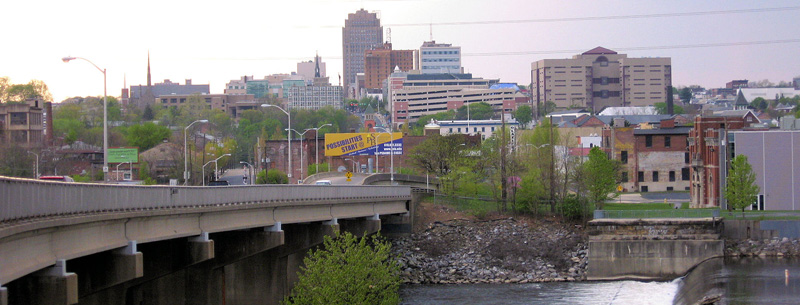2025 Allentown Visitors Guide
More often than not, Allentown, Pennsylvania may be better known for the musical lyrics of pop musician Billy Joel rather than for its vital role as an industrial boomtown. But, the city was on the national map long before Joel made it famous in 1982. Allentown is the largest of three area cities that compose an area of eastern Pennsylvania known as the Lehigh Valley. It is 60 miles north of Philadelphia and 90 miles west of New York City. Even so, Joel’s insightful lyrics were not far from the truth as he described the city more than 20 years ago.
While many of Allentown’s major industrial businesses have disappeared since the ‘80s as a result of foreign competition and other economic factors, the small city continues to serve as the corporate headquarters for several large, global companies including Agere Systems, Air Products & Chemicals, Mack Trucks, Olympus Corporation USA and Pennsylvania Power & Light, among.
Allentown is so named after the Chief Justice of colonial Pennsylvania’s Supreme Court, William Allen, an 18th-century American aristocrat, who originally labeled the river town Northamptontown. But, it would always be called Allentown.
With its location on the Lehigh River, Allen hoped he could turn the hunting lodge into a commercial center. Unfortunately, low water levels of the river made trade impractical there. So, up to the time of the American industrial revolution, Allentown remained a small village of Dutch and German farmers and tradesmen.
What made it a popular trading post, though, and brought about its major development, was that it had become the center of marketing for those area farmers.
Because of this, Allentown quickly found itself at the heart of the largest grain-producing region in the country. By the 1830s and 1840s, America’s industrial revolution, which was born in the Lehigh Valley, was taking off. The arrival of the Lehigh Canal, and later the railroad, opened up Allentown as a portal for efficiently bringing goods to market, and during the 1850s and 1860s, the area saw the rise of the strong local iron industry.
The nation’s growing railroad network proliferated Allentown and by the end of the Civil War, a huge influx of immigrant workers created a mini-Pittsburgh along the river banks. With the collapse of the railroad boom in the 1870s, Allentown reemerged at the beginning of the 20th century as a town filled with silk mills, parlor furniture factories, and producers of beer and cigars. Most recently, the community has become one filled with service trades and tourism and is ready to host more commercial development by implementing state-of-the-art technological advancements including a fiber optic loop and uninterrupted electrical service in the downtown area to attract potential business clients.
Allentown Attractions & Recreation
Recently the city embarked on a downtown revitalization project which includes a new attraction, Lehigh Landing, a multi-purpose complex on the former industrial property along the Lehigh River which will be anchored by America On Wheels Museum. Exhibits will include pieces from the Smithsonian Institution and Mack Trucks, whose headquarters are in Allentown. The Lehigh Landing project also will include a river walk, a tie-in to the Delaware and Lehigh Canal and boating activities along the river. Though immersed in a history of Industry, Allentown has a rich history dating back to the days of America’s infancy, but that doesn’t mean it’s a place without a unique identity.
Other area attractions include the Albertus Meyers Bridge built in 1912 as a streetcar and inter-urban line. Commonly called the 8th Street Bridge, at the time it was built, it was said to be the largest concrete bridge in the world.
The Allentown Art Museum was built as the First Presbyterian Church in 1902. The north wing, constructed in 1975, was designed by Edgar Tafel, Frank Lloyd Wright’s most famous student. A library room from a Frank Lloyd Wright house is part of the permanent display.
The Allentown Symphony Hall was built in the 1890s. In 1912, it was the site of speeches by the Progressive Party candidate Theodore Roosevelt and Democrat Woodrow Wilson. Today it is home of the Allentown Symphony Orchestra and is also used by touring theatrical groups.
Homeopathic Healing Art Plaque is a landmark that marks the location of the world’s first medical college exclusively devoted to the practice of homeopathic medicine called the North American Academy of Homeopathic Healing Art founded in April 1835.
Trout Hall was the summer home of James Allen, built in 1770 where the son of William and his family sought refuge during the Revolutionary war. In the later part of the 19th century, the home was completely encased in the walls of Muhlenberg College. Trout Hall was restored in 1905 as the first home of the Lehigh County Historical Society.
The City of Allentown offers recreational activities for people of all ages with a number of parks for picnicking, fishing or relaxing. The parks feature fitness trails, swimming, and ice skating and sledding in the winter.
Some area events include Lights In The Parkway, a massive Christmas light display; SportsFest, a sports-themed celebration featuring more than 25 competitive events from boxing and basketball to swimming and skateboarding in parks and sports facilities throughout Allentown in July; the Mayfair Festival of the Arts offers more than 200 performing and visual arts events and five days of music, dance, children’s activities, crafts and food; a two-mile Halloween Parade; car shows; the Andy Warhol exhibit; the Allentown Fair; and Civil War Voices: A Walk Among the Dead, to name a few of the major attractions in the community held throughout the year.
